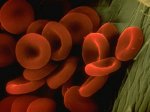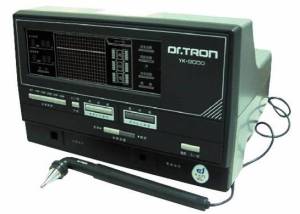This article was first seen in http://drbenkim.com/ph-body-blood-foods-acid-alkaline.htm, my views are in red text
 Is it true that each food that you eat can cause your blood to become more alkaline or acidic?
Is it true that each food that you eat can cause your blood to become more alkaline or acidic?
The answer is: not really. The pH of your blood is tightly regulated by a complex system of buffers that are continuously at work to maintain a range of 7.35 to 7.45, which is slightly more alkaline than pure water.
If the pH of your blood falls below 7.35, the result is a condition called acidosis, a state that leads to central nervous system depression. Severe acidosis – where blood pH falls below 7.00 – can lead to a coma and even death.
If the pH of your blood rises above 7.45, the result is alkalosis. Severe alkalosis can also lead to death, but through a different mechanism – alkalosis causes all of the nerves in your body to become hypersensitive and over-excitable, often resulting in muscle spasms, nervousness, and convulsions; it’s usually the convulsions that cause death in severe cases.
The bottom line is that if you’re out and about, your body is doing an adequate job of keeping your blood pH somewhere between 7.35 to 7.45, and the foods that you are eating are not causing any wild deviations of your blood pH.
So what’s up with all the hype about the need to alkalize your body? And what’s to be made of the claim that being too acidic can cause osteoporosis, kidney stones, and a number of other undesirable health challenges?
As usual, the answers to such questions about human health can be found by understanding basic principles of human physiology. So let’s take a look at the fundamentals of pH and how your body regulates the acid-alkaline balance of its fluids on a moment-to-moment basis.
pH is a measure of how acidic or alkaline a liquid is. With respect to your health, the liquids involved are your body fluids, which can be categorized into the following two main groups:
- Intracellular fluid, which is the fluid found in all of your cells. Intracellular fluid is often called cytosol, and makes up about two-thirds of the total amount of fluid in your body.
- Extracellular fluid, which is the fluid found outside of your cells. Extracellular fluids are further classified as one of two types:
- Plasma, which is fluid that makes up your blood.
- Interstitial fluid, which occupies all of the spaces that surround your tissues. Interstitial fluid includes the fluids found in your eyes, lymphatic system, joints, nervous system, and between the protective membranes that surround your cardiovascular, respiratory, and abdominal cavities.
Your blood (plasma) needs to maintain a pH of 7.35 to 7.45 for your cells to function properly. Why your cells require your blood to maintain a pH in this range to stay healthy is beyond the scope of this article, but the most important reason is that all of the proteins that work in your body have to maintain a specific geometric shape to function, and the three-dimensional shapes of the proteins in your body are affected by the tiniest changes in the pH of your body fluids.
The pH scale ranges from 0 to 14. A liquid that has a pH of 7 is considered to be neutral (pure water is generally considered to have a neutral pH). Fluids that have a pH below 7 – like lemon juice and coffee – are considered to be acidic. And fluids that have a pH above 7 – like human blood and milk of magnesia – are considered to be alkaline.
It’s important to note that on the pH scale, each number represents a tenfold difference from adjacent numbers; in other words, a liquid that has a pH of 6 is ten times more acidic than a liquid that has a pH of 7, and a liquid with a pH of 5 is one hundred times more acidic than pure water. Most carbonated soft drinks (pop) have a pH of about 3, making them about ten thousand times more acidic than pure water. Please remember this the next time you think about drinking a can of pop.
When you ingest foods and liquids, the end products of digestion and assimilation of nutrients often results in an acid or alkaline-forming effect – the end products are sometimes called acid ash or alkaline ash.
Also, as your cells produce energy on a continual basis, a number of different acids are formed and released into your body fluids. These acids – generated by your everyday metabolic activities – are unavoidable; as long as your body has to generate energy to survive, it will produce a continuous supply of acids.
So there are two main forces at work on a daily basis that can disrupt the pH of your body fluids – these forces are the acid or alkaline-forming effects of foods and liquids that you ingest, and the acids that you generate through regular metabolic activities. Fortunately, your body has three major mechanisms at work at all times to prevent these forces from shifting the pH of your blood outside of the 7.35 to 7.45 range.
These mechanisms are:
- Buffer Systems
- Carbonic Acid-Bicarbonate Buffer System
- Protein Buffer System
- Phosphate Buffer System
- Exhalation of Carbon Dioxide
- Elimination of Hydrogen Ions via Kidneys
It’s not in the scope of this article to discuss the mechanisms listed above in detail. For this article, I only want to point out that these systems are in place to prevent dietary, metabolic, and other factors from pushing the pH of your blood outside of the 7.35 to 7.45 range.
When people encourage you to “alkalize your blood,” most of them mean that you should eat plenty of foods that have an alkaline-forming effect on your system. The reason for making this suggestion is that the vast majority of highly processed foods – like white flour products and white sugar – have an acid-forming effect on your system, and if you spend years eating a poor diet that is mainly acid-forming, you will overwork some of the buffering systems mentioned above to a point where you could create undesirable changes in your health.
I agree to the statement above. Even though our system is smart enough to maintain our blood pH at a consistent mild alkaline level, a dietary habit which is loaded with refined foods (modern diet) will overtax our system. That is why a balance of 80% alkaline forming food and 20% acid forming food dietary ratio is recommended for a healthier blood state (you are allowed one ‘cheat’ meal though per week if you follow through your diet plan).
The question here is : Are you committed to changing your dietary habits now or contented with the knowledge that our body can regulate our blood state every time and a diet change is not necessary until there is a health problem?
For example, your phosphate buffer system uses different phosphate ions in your body to neutralize strong acids and bases. About 85% of the phosphate ions that are used in your phosphate buffer system comes from calcium phosphate salts, which are structural components of your bones and teeth. If your body fluids are regularly exposed to large quantities of acid-forming foods and liquids, your body will draw upon its calcium phosphate reserves to supply your phosphate buffer system to neutralize the acid-forming effects of your diet. Over time, this may lead to structural weakness in your bones and teeth.
Drawing on your calcium phosphate reserves at a high rate can also increase the amount of calcium that is eliminated via your genito-urinary system, which is why a predominantly acid-forming diet can increase your risk of developing calcium-rich kidney stones.
This is just one example of how your buffering systems can be overtaxed to a point where you experience negative health consequences. Since your buffering systems have to work all the time anyway to neutralize the acids that are formed from everyday metabolic activities, it’s in your best interest to follow a diet that doesn’t create unnecessary work for your buffering systems.
Acid and Alkaline-Forming Effects of Common Foods
Generally speaking, most vegetables and fruits have an alkaline-forming effect on your body fluids.
Most grains, animal foods, and highly processed foods have an acid-forming effect on your body fluids.
Your health is best served by a good mix of nutrient-dense, alkaline and acid-forming foods; ideally, you want to eat more alkaline-forming foods than acid-forming foods to have the net acid and alkaline-forming effects of your diet match the slightly alkaline pH of your blood.
Remember the 80:20 rule. 80% alkaline forming foods : 20% acid forming foods.
I would recommend for those vegetable-challenged eaters out there, to get a good greens product to supplement your diet’s lack of alkaline forming food.
The following lists indicate which common foods have an alkaline-forming effect on your body fluids, and which ones result in acid ash formation when they are digested and assimilated into your system.
Foods that have a Moderate to Strong Alkaline-Forming Effect
Watermelon
Lemons
Cantaloupe
Celery
Limes
Mango
Honeydew
Papaya
Parsley
Seaweed
Sweet, seedless grapes
Watercress
Asparagus
Kiwi
Pears
Pineapple
Raisins
Vegetable juices
Apples
Apricots
Alfalfa sprouts
Avocados
Bananas
Garlic
Ginger
Peaches
Nectarines
Grapefruit
Oranges
Most herbs
Peas
Lettuce
Broccoli
Cauliflower
Foods that have a Moderate to Strong Acid-Forming Effect
Alcohol
Soft drinks (pop)
Tobacco
Coffee
White sugar
Refined Salt
Artificial sweeteners
Antibiotics (and most drugs)
White flour products (including pasta)
Seafood
White vinegar
Barley
Most boxed cereals
Cheese
Most beans
Flesh meats
Most types of bread
Please note that these lists of acid and alkaline-forming foods are not comprehensive, nor are they meant to be.
If you’re eating mainly grains, flour products, animal foods, and washing these foods down with coffee, soda, and milk, you will almost certainly improve your health by replacing some of your food and beverage choices with fresh vegetables and fruits.
The primary purpose of this article is to offer information that explains why I believe that you don’t need to take one or more nutritional supplements for the sole purpose of alkalizing your body. Your body is already designed to keep the pH of your body fluids in a tight, slightly alkaline range.
Then again, we should not fall into the misconception that supplement alone can maintain the body at an alkaline state. No product or machine can replace a good healthful diet and exercise.
Point to note: we should begin even before we fall ill or diagnosed with a certain condition! Most do it AFTER, and hope for a quick fix! Sorry buddy but it does not work that way! You reap what you sow.
The ideal scenario is to make fresh vegetables and fruits the centerpieces of your diet, and to eat small amounts of any other nutrient-dense foods that your appetite calls for and that experience shows your body can tolerate.
Besides food, our body’s bio-electricity is also another area which we can be mindful of.
You might also like to check out a physiotherapy device from Japan which can help enhance the blood purify properties of the body through increasing our cellular bio-electricity. Healthy cells maintain their bio-electricity at 70mv. A healthy constant level of bio-electricity can help maintain proper exchange transport of calcium and phosphate ions between cells and blood to help maintain blood pH.
If you have any questions or comments on this topic, please feel free to add them to the comments section below. Thank you.
Article borrowed from http://drbenkim.com/ph-body-blood-foods-acid-alkaline.htm
Filed under: Right 2 Wellness | Tagged: acidosis, alkalosis, pH, purify blood | 4 Comments »



 Sole distributor of Dr. TRON in South East Asia
Sole distributor of Dr. TRON in South East Asia
